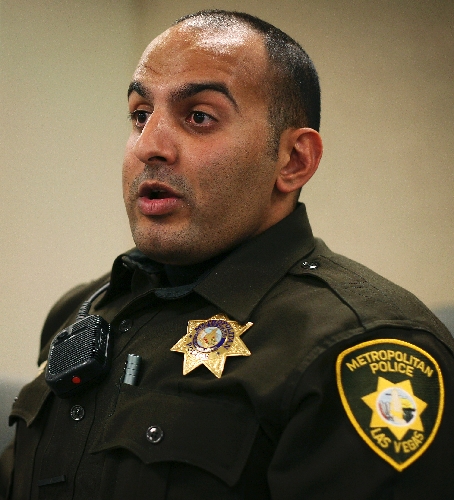Accident is a lesson for Las Vegas police officer
He lost his partner.
He endured a year of physical and mental rehab.
He faced the chance he could never be a cop again.
And when he walked back into a police substation Nov. 2 to work a patrol shift again, it was like starting all over again.
"It felt like my first day on the street," Las Vegas police officer David Nesheiwat said .
The 26-year-old is back at work patrolling downtown, continuing the job he said he never considered quitting even after the October 2009 wreck that killed his partner, Milburn "Millie" Beitel.
That crash was one of three fatal accidents in six months for the Metropolitan Police Department. The rash of driving deaths prompted Sheriff Doug Gillespie in December 2009 to revamp his agency's driving policy and to put a new emphasis on wearing seat belts and slowing down.
A year later, the policy and an internal safe-driving campaign seem to be working.
"Speed is down. Seat belt usage is up. That tells me we're sending a good message," Gillespie said.
Overall, police crashes are down 4 percent from a year ago, according to department figures covering everything from fender benders to serious wrecks.
Officers were found to have been wearing seat belts in every one of the roughly 460 crashes scrutinized by the Accident Review Board through September, the sheriff said. The speeds involved in those crashes have fallen.
"Everything is trending in the right direction," Gillespie said.
That was his goal when he changed the driving policy 12 months ago.
In two of the fatal cases, the officers were speeding and not wearing seat belts when they crashed.
In June 2009, officer James Manor's patrol car was going more than 100 mph as he responded to a domestic violence call when a truck turned left into his path. His car did not have lights or sirens on.
Four months later, Beitel was killed after losing control of his speeding patrol car. He wasn't wearing a seat belt. Nor was Nesheiwat, who was thrown from the car when it rolled.
The new policy reinforced a requirement that seat belts must be worn unless the officer is approaching a scene at low speeds. It also allows officers to drive no faster than 20 mph over the speed limit except in vehicle pursuits.
The sheriff also required more driver training for newer officers.
The Metropolitan Police Department followed the policy change in July with a safe-driving campaign that includes videos, posters and signs reminding officers to buckle up and drive safely.
Gillespie said he can't remember the last time he saw an officer not wearing a seat belt, but he still hears complaints about police cars driving too fast.
"I'm not naive enough to think everybody is driving appropriately," he said. "Police officers tend to push the envelope a little bit. When I was out there, I won't say I wasn't doing that either."
Gillespie intends to keep pushing the message to keep his officers from growing complacent.
Chris Collins, head of the Police Protective Association, which represents about 2,500 rank-and-file officers, called the policy changes a "knee-jerk reaction" to an "anomaly."
Yet he acknowledged that officers are safer in the long run if they regularly wear seat belts.
"I think it's here to stay, and I think it will be helpful," Collins said.
Nesheiwat has done his part, formally and informally, to remind fellow officers about the importance of wearing their seat belts.
He has spoken to police academy recruits, and he said he would pull an officer aside if he saw that officer not buckling up.
He wants them to learn from the mistakes he and his partner made.
"If me getting hurt saves people in the long run, then I'm good with that," Nesheiwat said.
And he sets the example every day when he clicks in behind the wheel.
"Pretty religiously," he said.
Contact reporter Brian Haynes at bhaynes@reviewjournal.com or 702-383-0281.






















